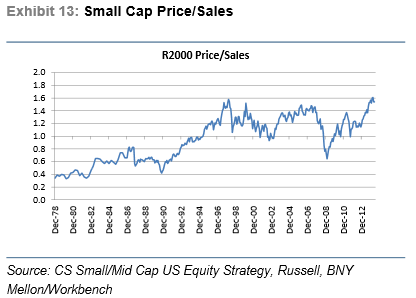What could derail stocks' record run
The S&P 500 jumped over the 1,900 level for the first time in history during Tuesday trading, building on Monday's rip-roaring move higher that pushed the Dow Jones Industrial average over the resistance zone at 16,600. Cue the fireworks and confetti, right?
First, here are a few niggling point of concern worth mentioning.
To start, there wasn't exactly a clear-cut catalyst for this week's upside surge. The pro-independence referendum went Moscow's way in Eastern Ukraine, leading the rebel leaders to give Kiev a 48-hour ultimatum to remove their "occupying" forces. Maybe the market was worried Russian tanks would roll over the border Monday morning, and were pleasantly surprised when Russian President Vladimir Putin seemed instead to use the referendum result as an entrée into more diplomacy.
Actually, a look at the areas of the market doing best suggests the real motivation was a surge of short covering. The weakest, most shorted stocks did best, including homebuilders, which have been under pressure due to the negative impact higher interest rates are having on mortgage activity. That's a short-term trading-swing type of move -- not necessarily a sign of robust, broad-based buying interest.
The skeptic within me sees trouble elsewhere, too. The fundamentals are missing, with the economic data still disappointing overall as investors ignore things like earnings revisions and leverage ratios. The technicals are also missing, with breadth (or the number of stocks participating to the upside), well below levels seen earlier this year. Small caps remain under pressure, with the Russell 2000 small-cap index more than seven percent below its March high. And the geopolitical situation seems headed for an escalation of violence as Kiev appears uninterested in abiding by the rebel's 48-hour deadline (which ends Wednesday).
Even seasonality is working against the bulls here. Between 1950 and 2010, the six months from May to October resulted in a loss of 909 Dow points. The other six months were entirely responsible for the market's rise.
But some optimism is justified as well.
It's true that large-caps and small-caps are suffering a rare separation in performance, on a level that has only been seen about eight times in the last 70 years. And it's also true this tends to result in a downside drift by the S&P 500. But in two exceptions to this tendency, stocks rose -- a lot -- including the market's run higher between 1994 and 2000.
Yet, this seems to be the outside scenario at this point, especially with small-caps looking vulnerable to more downside moves.
This expectation is shared by small-cap stock analysts at Credit Suisse, who in a note to clients on Friday outlined their argument that the sell-off in the Russell 2000 isn't yet finished.
For one, the average pullback in small-caps since the mid-1990s averages 21 percent, whereas the current slide stands at 7.4 percent (with a maximum decline of 10 percent set during the day on Friday).
Second, three of the six drivers the Credit Suisse analysts track for small-cap performance are negative. These include valuation, earnings revisions/earnings per share growth and investor sentiment. Only one is positive, mergers and acquisitions.
The analysts started feeling nervous about the performance of the Russell 2000 given what they saw as "alarmingly expensive valuations" that could no longer be justified. In their minds, valuations are still problematic. The Russell 2000's forward price-to-earnings multiple was at 19.6x at the start of the year and was at 18.2 as of May 6. Within the 19x to 20x range, small-caps decline about 64 percent of the time over the next 12 months, report the analysts.
The situation is even worse on a price-to-sales metric. The chart above tracks the price/sales multiple of the Russell 2000 over the past three decades. At 1.54x through early May, this measure was still barely below all-time highs. Small-caps overall have never risen higher on a 12-month forward basis when this multiple has been above 1.5x in the past, according to the CS analysts.
Overall, CS is looking for the Russell 2000 to fall toward the 1,000 level -- which was last seen in July -- before finding support and setting a new base. The good news is they expect the decline will be a buying opportunity heading into a late-year rebound. Should this decline materialize, it may be hard to see the S&P 500 resisting the selling pressure.


